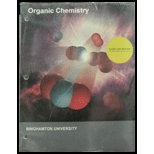
Concept explainers
Interpretation:
A stepwise mechanism for the free-radical chlorination of
Concept introduction:
>The breaking of a covalent bond between two atoms in a way that each atom retains one of the electrons from the bond is called homolytic cleavage.
>The breaking of a covalent bond between two atoms in a way that one of the atoms retains both the electrons from the bond is called heterolytic cleavage.
>The movement of a single electron is shown by a Fishhook arrow and is called as single electron.
>Initiation describes the initial step of formation of radicals.
>Propagation is the chain of radical reactions. Once the radical formed in the initiation step, it reacts with suitable molecules.
Want to see the full answer?
Check out a sample textbook solution
Chapter 10 Solutions
Organic Chemistry (Binghampton University)
- 13. Explain why 92% of 2,4-pentanedione exist as enol in hexane but only 15% of this compound exist as enol tautomer in water?arrow_forwardExplain the experimental procedure of the laboratory preparation of the synthesis of fluorobenzene from aniline (paragraph form) Explain the chemistry behind the synthesis of fluorobenzene from aniline (paragraph form)arrow_forwardExplain the experimental procedure of the laboratory preparation of the synthesis of fluorobenzene from aniline Explain the chemistry behind the synthesis of fluorobenzene from anilinearrow_forward
- Calculate theoretical yield of the Grignard reaction synthesis of triphenylmethanol from bromobenzene. Amounts of products used are listed in the image.arrow_forwardWrite mechanism of halogenation of benzene and explain each step of reactionarrow_forwardwrite the reaction of the action of methyl-2, bromo-2-propane with hot KOH solution. a) Name the formed product b) Explain why the reaction takes place according to the SNI mechanismarrow_forward
- Write the sequence of steps required for the conversion of benzene into benzenediazonium chloride.arrow_forwardGive reaction equations for the preparation of a silane, for when silane is heated to 500C, and of hydrosilylation.arrow_forwardThe Friedel-Crafts Alkylation of p-xylene n-propyl bromide can result in an isopropyl as well as n-propyl substitution. A) Write the chemical equation involved in this reaction. B) Which will be the major and minor product? What do you expect will be the ratio of n-propyl to isopropyl substitution for p-xylene?arrow_forward
- Explain in detail the difference in the rate of free radical bromination reactions of toluene and cyclohexane. Write neatlyarrow_forwardIn terms of steric effect and electron delocalization, explain: the solubility of acetylenic compound in many basesarrow_forwardWrite the mechanism for the ionic addition of HBr to 2-methylpropene and write the mechanism for the ionic addition of HBr to 2-methylpropene in the presence of dialkyperoxides and compare both, state any specific diffarrow_forward
 Macroscale and Microscale Organic ExperimentsChemistryISBN:9781305577190Author:Kenneth L. Williamson, Katherine M. MastersPublisher:Brooks Cole
Macroscale and Microscale Organic ExperimentsChemistryISBN:9781305577190Author:Kenneth L. Williamson, Katherine M. MastersPublisher:Brooks Cole
